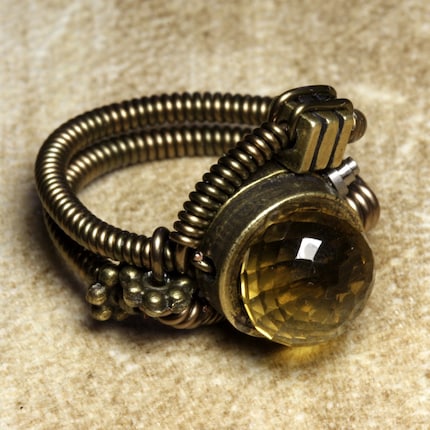Steampunk Jewelry : Topaz Ring
Yellow orange Topaz is the stone for November and Blue Topaz for December . In the upcoming month i will be adding more topaz ring to my ETSY shop as i receive new colors .
Color and varieties
Pure topaz is colorless and transparent but is usually tinted by impurities; typical topaz is wine, yellow, pale gray or reddish-orange, blue brown. It can also be made white, pale green, blue, gold, pink (rare), reddish-yellow or opaque to transparent/translucent.Orange topaz, also known as precious topaz, is the traditional November birthstone, the symbol of friendship, and the state gemstone for the US State of Utah.
Imperial topaz is yellow, pink (rare, if natural) or pink-orange. Brazilian Imperial Topaz can often have a bright yellow to deep golden brown hue, sometimes even violet. Many brown or pale topazes are treated to make them bright yellow, gold, pink or violet colored. Some imperial topaz stones can fade on exposure to sunlight for an extended period of time. Blue topaz is the Texas state gemstone. Naturally occurring Blue Topaz is quite rare. Typically, colorless, gray or pale yellow and blue material is heat treated and irradiated in order to produce a more desired darker blue.
Mystic topaz is colorless topaz which has been artificially coated giving it the desired rainbow effect.
Localities and occurrence
Topaz Mountain, Utah
Topaz is commonly associated with silicic igneous rocks of the granite and rhyolite type. It typically crystallizes in granitic pegmatites or in vapor cavities in rhyolite lava flows like those at Topaz Mountain in western Utah. It can be found with fluorite and cassiterite in various areas including Ural and Ilmen mountains of Russia, in Afghanistan, Sri Lanka, Czech Republic, Germany, Norway, Pakistan, Italy, Sweden, Japan, Brazil, Mexico, Flinders Island and the United States.
Some clear topaz crystals from Brazilian pegmatites can reach boulder size and weigh hundreds of pounds. Crystals of this size may be seen in museum collections. The Topaz of Aurungzebe, observed by Jean Baptiste Tavernier measured 157.75 carats.
Colorless and light-blue varieties of topaz are found in Precambrian granite in Mason County, Texas within the Llano Uplift. There is no commercial mining of topaz in that area.
Etymology and historical and mythical usage
The name "topaz" is derived from the Greek Τοπάζιος (Τοpáziοs), the author of one of the first systematic treatises on minerals and gemstones dedicated two chapters on the topic in 1652.In the Middle Ages, the name topaz was used to refer to any yellow gemstone, but now the name is only properly applied to the silicate described above.
Many modern English translations of the Bible, including the King James Version mention Topaz in Exodus 28:17 in reference to a stone in the Hoshen: "And thou shalt set in it settings of stones, even four rows of stones: the first row shall be a sardius, a topaz, and a carbuncle(Garnet): this shall be the first row."
However, since these translations as topaz all derive from the Septuagint translation topazi[os], which as mentioned above referred to a yellow stone that was not topaz, but probably chrysolite, it should be borne in mind that topaz is not meant here. The masoretic text (the Hebrew on which most modern Protestant Bible translations of the Old Testament are based) has pitdah as the gem the stone is made from; some scholars think it is related to an Assyrian word meaning flashed.[citation needed] More likely, pitdah is derived from Sanskrit words (pit = yellow, dah = burn), meaning "yellow burn".
| Etsy: Your place to buy & sell all things handmade CatherinetteRings.etsy.com |






